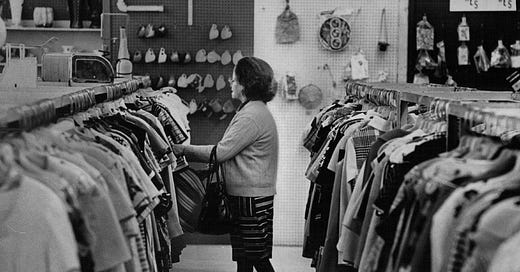
A few months ago, I went to a secondhand store and purchased yet another oatmeal-color sweater (you can read more about this terrible habit that I’m trying to break here). When I got to the register, the cashier innocently said, “This is so cute AND it’s guilt-free.” I smiled and nodded in agreement because I knew what she meant by it. I am familiar with the term as one of the billions of people who have been exposed to toxic diet culture. The idea is that low-calorie ice cream is “guilt-free” because it has the same-ish feeling of real ice cream without the “guilt” of calories and sugar.
When applied to a garment, this would mean you get all the fun of shopping and getting something new for yourself, but without the guilt of knowing we’re contributing to a cycle of new fashion all the time. But following through with the guilt-free logic, what’s the problem with buying the real thing if you’re going to actually enjoy it?
Let’s be honest with ourselves.
Secondhand is better than buying new fast-fashion, but when I got that sweater, I was still buying more clothing. I didn’t feel guilty for buying the sweater, necessarily, and I don’t think it would be helpful anyway if I did. At the same time, it’s not beneficial to say I was “shopping sustainable” by going into that secondhand shop and buying a sweater I didn’t need. Plus, I can’t trace the origins of that sweater, so at most, I extended its life cycle a little longer. That’s OK, I’m not going to ethical fashion hell for not making the perfect purchase. And neither are you for the ones you make. But buying secondhand isn’t a wrong-doing free pass on clothing.
What should we call sustainable?
It’s important to think about sustainable fashion as a movement, not a specific type of clothing. When we apply it to clothing, like something secondhand, it may assign something to that garment that isn’t there. Radical action against climate change and the unethical treatment of workers is not going to be bought in a consignment shop. While investing in small brands, vintage, and upcycling is certainly a better way to shop, buying more clothing shouldn’t be your only trick. I want to be clear that I love vintage shopping and very much support it. It would make me a huge hypocrite to suggest otherwise. It’s just not the end of the changes we should make.
So, can you be a sustainable fashion person?
Yes, but don’t fall into the trap. Just because something says it's sustainable doesn’t mean it fits into the larger movement to make fashion better. For example, a fast-fashion brand that has a “sustainable” denim line because its using recycled materials, is not necessarily contributing to the change unless they are lowering their productions, taking control of their supply chains, and improving their materials. On the secondhand side, see above.
If you want to call yourself a sustainable fashion person, that’s great. But you have to go all the way in. You can sign petitions from garment workers seeking pay and better working conditions. You can donate to workers who are fighting for a more equitable fashion industry. And, you can call your legislators and ask them to support bills and organizations that are working to have more regulation on fashion.
*This Stuff is a newsletter by me! fashion journalist, Alyssa Hardy. Three times a week, I unpack the ways our clothes impact the world through news, essays, interviews and more. Subscribe for free here and follow me on Instagram, Facebook and Twitter.*



